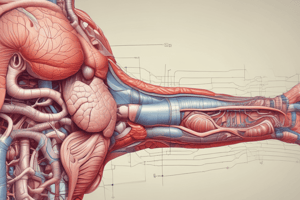Podcast
Questions and Answers
What is the primary function of the small intestine in the digestive system?
What is the primary function of the small intestine in the digestive system?
- Formation and storage of feces
- Major site of nutrient absorption (correct)
- Storage and concentration of bile
- Secretion of digestive enzymes
Which organ produces bile, a substance crucial for fat digestion?
Which organ produces bile, a substance crucial for fat digestion?
- Gallbladder
- Liver (correct)
- Stomach
- Pancreas
Which of the following is an example of mechanical digestion?
Which of the following is an example of mechanical digestion?
- Conversion of carbohydrates to monosaccharides in the small intestine
- Absorption of nutrients across the intestinal wall
- Enzymatic breakdown of proteins in the stomach
- Churning of food in the stomach (correct)
What is the role of the pancreas in digestion?
What is the role of the pancreas in digestion?
What digestive process refers to the breakdown of food into smaller molecules by enzymes?
What digestive process refers to the breakdown of food into smaller molecules by enzymes?
Which hormone stimulates secretions and motility in the digestive system?
Which hormone stimulates secretions and motility in the digestive system?
Which of the following is a disorder characterized by acid reflux into the esophagus?
Which of the following is a disorder characterized by acid reflux into the esophagus?
What are the end products of protein digestion?
What are the end products of protein digestion?
Flashcards
Ingestion
Ingestion
The process of taking in food via the mouth.
Digestion
Digestion
The mechanical and chemical breakdown of food into smaller molecules.
Absorption
Absorption
The movement of digested nutrients from the small intestine into the bloodstream.
Elimination
Elimination
Signup and view all the flashcards
Mechanical Digestion
Mechanical Digestion
Signup and view all the flashcards
Chemical Digestion
Chemical Digestion
Signup and view all the flashcards
Villi
Villi
Signup and view all the flashcards
Microvilli
Microvilli
Signup and view all the flashcards
Study Notes
Key Functions
- Ingestion: Intake of food.
- Digestion: Mechanical and chemical breakdown of food.
- Absorption: Uptake of nutrients into the bloodstream.
- Elimination: Removal of waste products.
Organs Involved
- Mouth: Mechanical digestion (chewing) and chemical digestion (saliva).
- Pharynx: Passageway for food and air.
- Esophagus: Tube that carries food from the pharynx to the stomach.
- Stomach: Stores food, mixes it with gastric juices, and initiates protein digestion.
- Small Intestine: Major site of nutrient absorption, consisting of duodenum, jejunum, and ileum.
- Large Intestine: Absorbs water and electrolytes; forms and stores feces, consisting of cecum, colon, and rectum.
- Liver: Produces bile, crucial for fat digestion and absorption.
- Gallbladder: Stores and concentrates bile.
- Pancreas: Produces enzymes for digestion of carbohydrates, proteins, and fats.
Digestive Processes in Detail
- Mechanical Digestion: Physical breakdown of food, e.g., chewing, stomach churning, small intestine segmentation.
- Chemical Digestion: Breakdown of food into smaller molecules using enzymes. Enzymes are specific for nutrients, breaking down starch, proteins, and fats into absorbable monosaccharides, amino acids, and fatty acids.
- Absorption: Nutrients absorbed through the walls of the small intestine into the bloodstream. Villi and microvilli increase the surface area for absorption.
Types of Nutrients and their Digestion
- Carbohydrates: Broken down into monosaccharides (primarily glucose) through enzyme action.
- Proteins: Broken down into amino acids in the stomach and small intestine via enzyme action.
- Lipids/Fats: Broken down into fatty acids and glycerol. Bile salts from the liver emulsify fats for easier digestion.
Regulatory Mechanisms
- Nervous system and hormones (e.g., gastrin, secretin, cholecystokinin) regulate digestion, stimulating or inhibiting secretions and motility.
Digestive System Disorders
- Gastroesophageal reflux disease (GERD): Acid reflux into the esophagus.
- Peptic ulcers: Sores in the stomach or duodenum lining.
- Irritable bowel syndrome (IBS): Functional large intestine disorder.
- Inflammatory bowel disease (IBD): Chronic inflammation of the digestive tract.
- Diverticulosis: Formation of pouches in the colon.
- Diverticulitis: Infected pouches in the colon.
Importance of a Healthy Digestive System
- Proper nutrient absorption maintains well-being.
- Digestive issues can lead to malnutrition, vitamin deficiencies, and chronic conditions.
- A healthy diet, hydration, and lifestyle choices support the digestive system.
Accessory Organs
- Liver, gallbladder, and pancreas (accessory organs, not part of the alimentary canal) are vital. They produce and secrete fluids (bile and pancreatic juice), essential for breakdown and absorption.
Studying That Suits You
Use AI to generate personalized quizzes and flashcards to suit your learning preferences.




